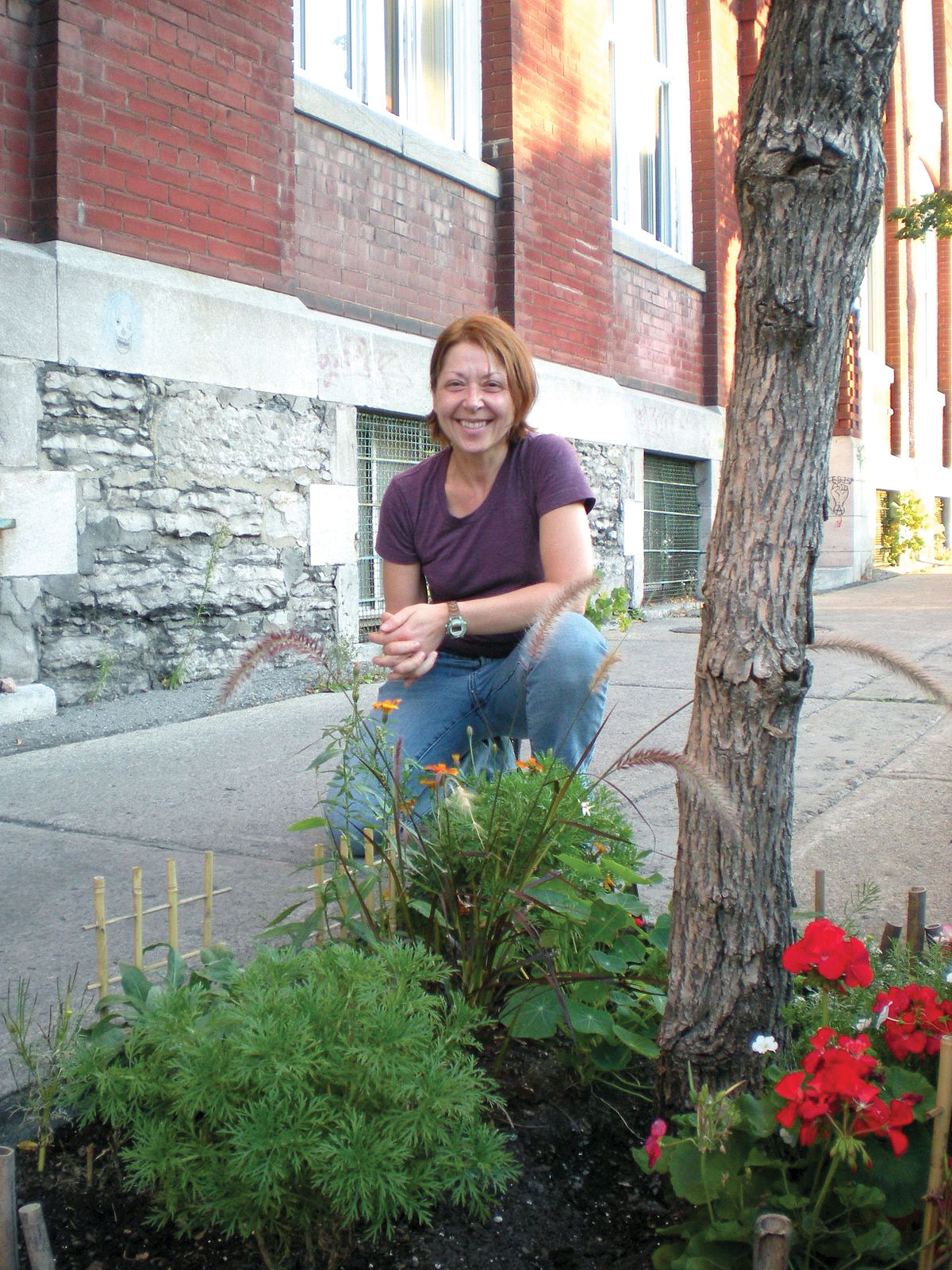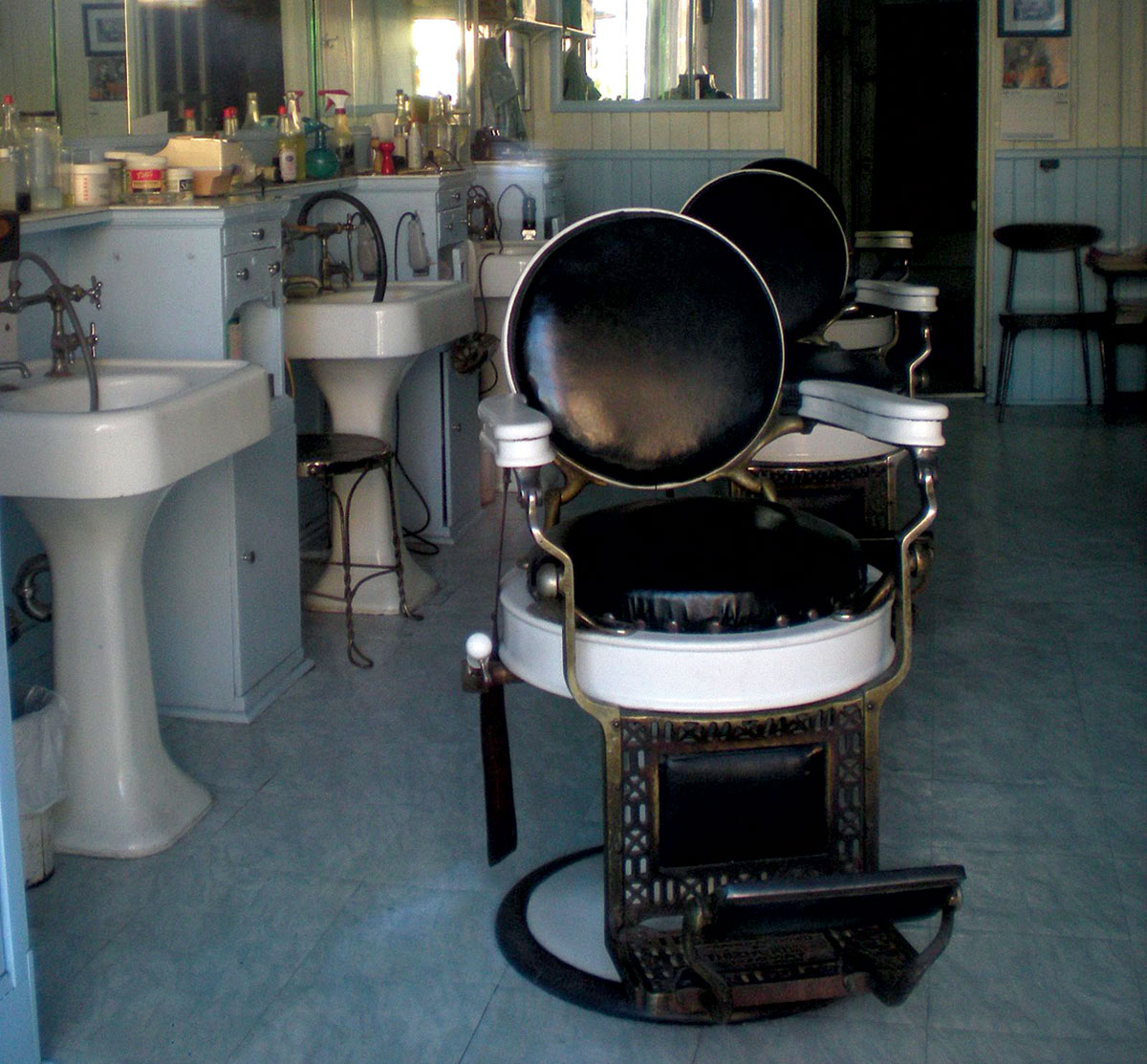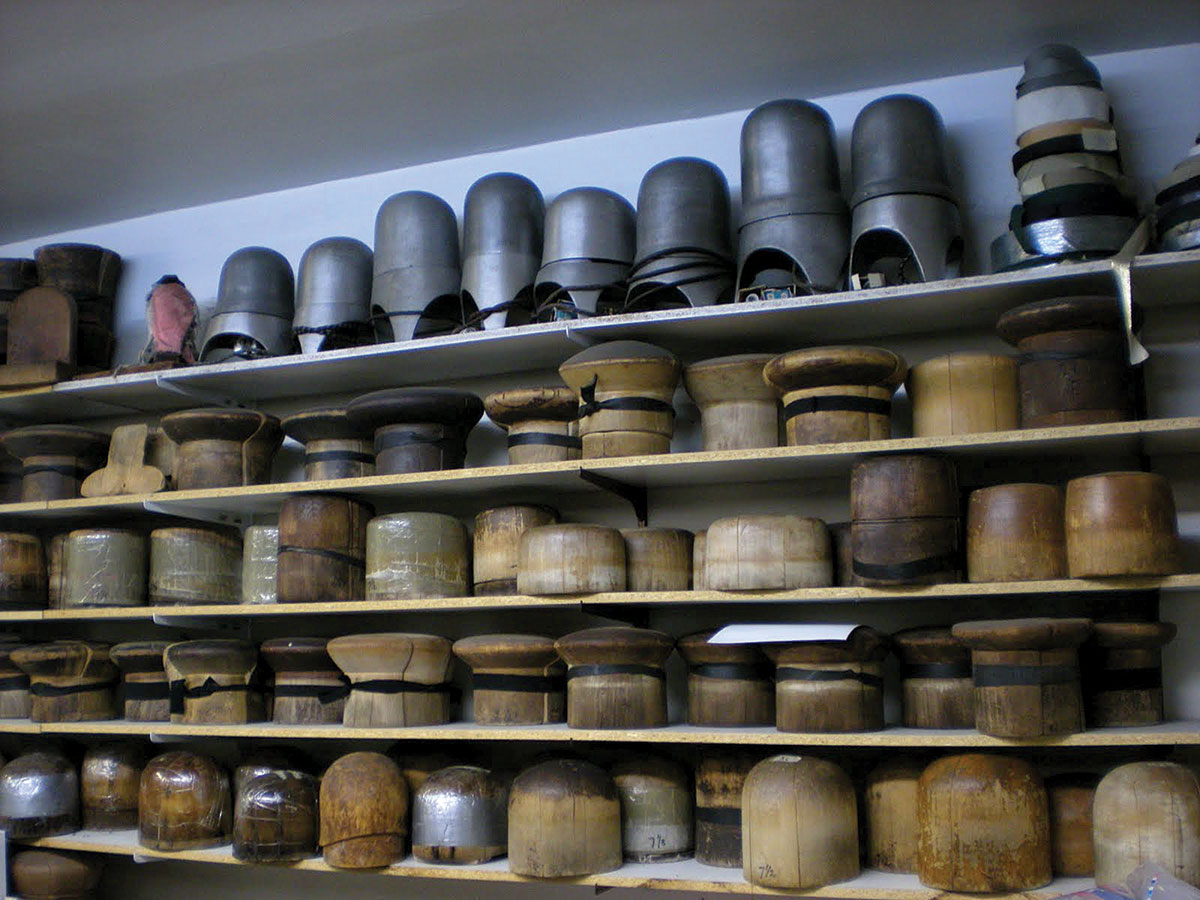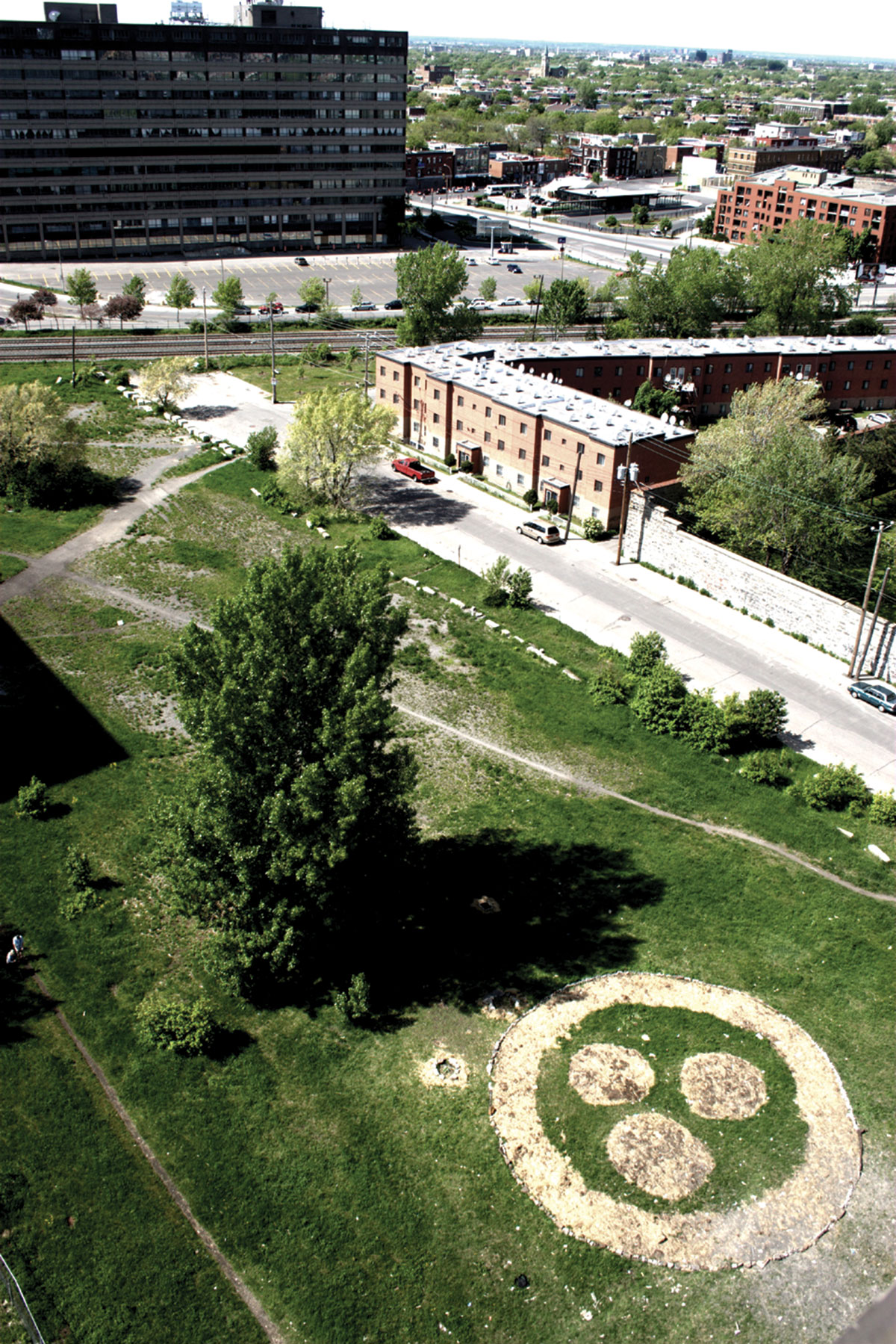
Urban gardener Diane Boyer.
Sarah Gilbert has lived in Montreal’s Mile End—a high-density multicultural area, long popular with artists but increasingly gentrified in recent years—since 1990. In 2008, she began recording the neighbourhood’s stories, in a blog titled Mile Endings.
Voice of the Tree (September, 2008)
On St. Viateur East, in the shadow of an old factory building, a tree has a small sign around its slender trunk. It is part announcement, part polite plea, expressing the point of view of a tree whose bark is slowly being worn away: “THE TREE SAYS: ‘There is now, at the corner of St-Viateur East and St-Dominique Streets, a slew of bike racks for you to lock your bicycle. Why not take a few seconds and use them? I thank you!’ ”
In the square of earth around the tree, there is a tiny flower garden full of carefully kept marigolds, geraniums, nasturtiums, tall grasses, and daisies. Along the block between Casgrain and St. Dominique are three more trees with signs and neatly tended squares of garden around them.
Diane Boyer kneels on the sidewalk, deadheading the flowers and tending to the plants. She wears gardening gloves and knee protectors, and has a bucket of gardening tools she moves with her from square to square. A man wanders over to say good morning to her.
“I’m not awake yet,” he says, looking like he needs a cup of coffee.
“Gilles is a woodworker,” Diane explains. “He donated the bamboo and made the fences.” She points to the tiny fence posts protecting the flowers.
“We just had some good news. There’s an éco-quartier contest about improving your neighbourhood,” she says. “And we won! Helen Fotopulos, the mayor of the borough, is going to come give us a plaque.”
Diane has lived in the factory building, where both pianos and shirts were once made, for eleven years. She shares her fourth-floor loft with her cat, Picolo, who has extra toes on each paw and stalks around with a big-footed air of entitlement. Diane has plucked many sewing pins—relics from the shirt manufacturer—out from between the wooden floor planks. Her sunny space features a purple-painted leather couch and bright blue, green, and red walls adorned with wooden sculptures.
“I paint, draw, sculpt, and grow plants,” says Diane, whose day job involves re-recording English film and television dialogue into French. “I used to have a community garden, but I gave up my plot and I thought this space in front would be my garden. My neighbours pitched in and lent me hoses. I hook up to a water outlet at the loading dock on Casgrain, and when I connect two hoses together they reach all the way to St. Dominique.”
Since she started the gardens, in late June, people have been receptive to the trees’ messages about using bike racks instead of locking up to their trunks. As a result, the trees are doing better. Diane indicates a fresh sprig poking out of the same trunk where the bark had been worn away.
“The only thing we can’t control is the cats and dogs who wander at night. The cats use the gardens as a litter box. But there’s very little damage.”
As Diane adjusts one of the tree signs, two women walk out of the building.
“You’re the one who did these gardens? ” they ask. “They’re great!”
Diane smiles and plucks a dry leaf off a daisy.
Caps for Sale (November, 2008)
As soon as the Laundromat turns into a bistro, or the garage on the corner becomes a condo, or the appliance repair shop reopens as a boutique, their old selves evaporate.
Sometimes I walk down St. Viateur trying to remember: What was the crêpe place before the big flat griddles and the paper cones for take-out crêpes arrived? What used to be on the corner where the fancy ink and stationery shop now is? The chocolatier two doors down sells tiny, pretty chocolates for two dollars each. What was there before?
The neighbourhood is changing so fast I can hardly keep up.
Maybe that’s why I’m so happy to find Barry Shinder at Maple Leaf Hat and Cap Manufacturing Company, on St. Laurent, north of St. Viateur. When I ask him how long he’s been here, he crows, “Too long!”

Barry Shinder outside Maple Leaf Hat and Cap during its final days.
He’s stitching caps on the heavy black Singer sewing machine once used by his father when he started the business, in 1930, on St. Laurent, between Pine and Prince Arthur.
“I’ve been on St. Laurent all my life,” Barry says. “Me and my brothers used to lie on the sewing tables as babies.”
Barry lives with his wife and daughter in the apartment where he grew up, above the cap factory. He works weekends and nights, sometimes until 11 P.M.
“It’s convenient,” he says. “I’m a workaholic.”
Barry, who is sixty-one and boasts an athletic frame and a quick wide smile, picks up a flat cap, also known as a newsboy, and admires it.
“The beauty of men’s hats? The style is what it was in my father’s day in the nineteen-thirties, and it’s still going.”
The caps are like the ones stacked high in Caps for Sale, the classic children’s book about a cap peddler who falls asleep under a tree and wakes to find that monkeys have stolen his pile of hats. Barry’s 2008 models are dark-coloured wool, tweed, or corduroy patchwork, with a brim and a button on top. Some have a snap fastener on the brim.
Talking to Barry Shinder is like finding a living link between the neighbourhood’s past and present. I’ve been in Mile End through two decades of changes, but he’s been here his whole life. And Barry’s memory seems to keep up with the neighbourhood’s changes just fine, piling up the layers of history like a stack of caps: “The Mile End station was over where Million Carpets and Tiles is. Me and my cousin used to hop trains to Outremont….General Motors was on the corner of St. Viateur, where Yellow shoes is….Before Café Olimpico was Open Da Night, it was Tony and Franco’s.”
He talks without stopping his work, which at the moment is stitching sweatbands into poor-boy caps.
“I do the work of three, and so we’re actually six,” he explains, gesturing to the three Haitian women who’ve been sewing for him for a combined total of thirty-nine years. Margaret, Jacqueline, and Rose use words like “cool” and “respectful” to describe their boss.
“Every year it gets tougher,” Barry says of the business, citing the flood of inexpensive imports from China as a factor. “At one point I wanted my son to build it up. But why ruin his life? He’s going to work sixty to seventy hours a week in here? Is there a future in this? I can’t see it. I’m a dying breed.”
After he stitches the sweatbands, one by one, into a pile of caps, Margaret takes them and sews in the label of a clothing company. As it was in Barry’s father’s day, ninety per cent of Maple Leaf’s work is contract.
The caps they make will sell at the historic high-end Henri Henri hat store on St. Catherine, or at l’Hiver en Folie shops across Quebec. Yet Maple Leaf Hat remains strangely invisible—you could be wearing a Maple Leaf cap and never know it.
That’s sort of like eating a tofu wrap at le Cagibi, on St. Viateur at St. Laurent, without ever knowing it used to be a pharmacy with wooden apothecary shelves that held medicines and remedies before they held zines. Except the story of Barry Shinder and Maple Leaf Hat and Cap Manufacturing Company is not just a story of what used to be, it’s a story of what still is.
Postscript (January, 2010): The sign in the window of Maple Leaf Hat and Cap Manufacturing Company reads, “WE’RE CLOSING. EVERYTHING MUST GO.” I can’t believe it. I knew business was bad, but Barry Shinder tells me his manufacturing costs became too high. Last week his main client, the garment company who contracted him to make their caps, said they couldn’t afford his prices any more. Now, instead of sewing caps for the business his father started eighty years ago, Barry will commute to work in the Chabanel district and get paid a wage.
“I’ve never worked anywhere else,” he says. But he’ll be bringing his dad’s old Singer. “That is one thing I’d never sell.”
As I leave, wet snow is falling and I notice that just north of Barry’s place, in what used to be a neighbourhood tavern full of battered wicker chairs, a fancy new bar has opened up. Change is everywhere. Everything must go.
Secrets (July, 2009)
Tommy, the barber with the blue and yellow walls, museum-piece barber chairs, and tonics pickling in jars, says no to me.
“No. I don’t want. I have nothing to say. No, no. No.”
He fans me out of his shop with the newspaper he’s holding.
The bicycle-riding blade sharpener, who I’d heard of but never seen, also says no. He appeared like a mythical creature out of a billow of blowing snow one Friday afternoon this spring, with his grinding wheel in front of the handlebars and a hinged wooden box behind his seat. It was like running into a horse-drawn ice cart.
I yelled out to him, “I’ve been looking for you!”
He agreed to meet me when it wasn’t a blizzard. I asked if I could take his picture.

Tommy’s traditional barber shop.
“No, no, not today,” he said, and pedaled off into the flying snow, down toward the underpass, vaporizing like the sasquatch or Mr. Snuffleupagus.
And then he stood me up.
Barry Shinder at the cap factory, who gets his gigantic antique scissors honed by the bike sharpener, guessed it was because he works under the table and didn’t want publicity or problems.
Over on Parc Avenue, the staff of Chez Rose Marie Lingerie don’t want to spill the beans either.
“It’s a boring life, but it’s my life,” says Rose, who has wavy grey hair that tumbles over her shoulders. She’s an Armenian-born, Paris-trained corsetiere who’s been working in Montreal for close to fifty years. Her arm is in a sling from the strain of decades of bra-fitting and sewing alterations. She’s obviously a fountain of stories and inside information, but she refuses to give them up to me.

Shelves of hat moulds at Maple Leaf Hat and Cap Manufacturing Company.
“It’s an intimate thing,” Rose says. “It’s not like selling dresses.”
She and her daughter, Nora, are as discreet and enigmatic as special agents. The way they tell it, bra-fitting is an undercover operation.
“Sisters come in together, but they don’t even want the other to know what size they wear,” says Nora.
So, although sometimes it feels as if there’s no privacy in this village within a city, as it turns out, there are still some secrets in Mile End.
Postscript (September, 2009): Chez Rose Marie Lingerie remains mysterious until the end. In August, closing sale signs appear in the windows. I think this sudden turn of events is my chance: now they’ll want to tell all. But they don’t, at least not to me. Inside, for a few weeks, the store is packed with shoppers buying up bras at reduced prices. September 1st, it’s empty—counters and displays gone, pink walls bare of vintage Wonderbra posters.
“WE ARE NOW CLOSED,” reads a handwritten sign on the door. “PLEASE CALL US FOR ANY INFORMATION.”
I dial the number and get a recording: Rose’s voice telling me to leave a message. No information, no stories, no secrets.
Oasis (August, 2009)
In the alley behind Esplanade, there’s an oblong oasis: tomato plants, beans, squash, and tall purple-flowered amaranth rustle behind a chain-link fence.
On summer evenings I used to see a silver-haired gardener move along the rows, tending his plants. One time, a few years ago, I stopped and stared.
“Are those lemons? ”
Large fruit hung from the branches of a potted tree on the patio.
“Those are lemons, these are grapefruit,” the gardener said, gesturing in a casual way, as if anyone could grow this stuff on trees around here.
Years ago, in Spain, I travelled through lemon groves on an old train with wooden seats and open windows. The sight of citrus trees in an Esplanade alley was like magic, a sudden secret passageway to the Mediterranean, a quick ticket for the Lemon Express. I carry around with me the image of the luminous fruit growing there.
But when I finally return to tell the gardener how much his trees mean to me, I’m too late. I find a young couple out in the garden. George Moumouris tells me that his father, Spyridon, the keeper of the lemon tree, died in 2008.
“When I was growing up, he was out here until it was so dark you couldn’t see any more,” George remembers. “My mom would be inside, yelling, ‘Come in! Come eat with us!’ I didn’t used to get it. But now I do.”
Weekend mornings George is now out in the gardens, front and back, with a watering can. “My dad is all around me,” he says.
Spyridon Moumouris, or Spiros, as he was known, was born on the Greek island of Corfu, and moved to Mile End from Athens in 1969. He worked at a chemical factory and later switched to construction. In 1986, he bought the fourplex on Esplanade and hired neighbourhood kids to help him break up the pavement in back. His garden was born.

Spiros Moumoris’s lemon tree and backyard garden.
In the front yard, George notices the first ripe fig of the season, and picks it to share with his wife. The branches of the beautiful pear tree are laden with fruit, although he says it’s no good this year, too much rain. The grape arbour, thick-leafed and studded with bunches of grapes, shades a bench and a table on the patio—a cool place to sit. It reminds me of another shady grape-arbour haven up the street. I discover that Spiros helped plant that too.
It seems there are traces of Spiros all along the block; stories of things he grew or helped along. Derek Reade, who lives near the corner, with his garden full of black-eyed Susans and dahlias, says he once asked Spiros for advice on a fig tree.
“In the winter, put it in the closet. Just don’t forget to water it!” Spiros had instructed.
Reade followed this directive and, to his surprise, the tree produced figs that summer. But the second winter, once the tree was relegated to the closet, the watering was forgotten. The next spring, when Reade discovered the dried-up fruit tree, Spiros’s words came back to him.
“He could do anything,” says Jane Churchill, a former neighbour whose home Spiros renovated. “His specialty was plaster: curved walls, straight walls, ceilings….He was like the king of the neighbourhood. Everyone stopped to talk. He loved telling stories. He’d stand in front of his house with his little cup of coffee, a swirl of citrus around him.”
One of Spiros’s famous passions was his olive tree. “FRUIT-BEARING OLIVE TREE BEATS ODDS: ESPLANADE AVE. MAN PUTS HIS HEART AND SOUL INTO SAPLING FROM GREECE,” read a headline in the Gazette, in 1997. It described Spiros hugging the tree and admitting, “Sometimes, I’m crazy and I talk to her.”
“He brought it over from Greece as a cutting in his pocket,” explains Churchill.
“The olive tree got sick when he did,” recalls George, pointing out a planter at the side of the front garden with a skeleton of branches in it. “It was weird.”
The olive tree has faltered, but the rest of Spiros’s grove lives on—the fig, pear, grapefruit, and lemon trees; the vegetable garden Spiros started when George was a kid; the grapevines. The stories neighbours tell each other about him continue to thrive as well.
I missed my chance to seek his counsel, but I can still picture Spiros in his oasis, king of the neighbourhood, grower of lemons.
Field Custodian (September, 2009)
Past the east end of St. Viateur and beyond a gap in a chain-link fence, between the factory buildings and the railroad tracks, sits a grassy vacant lot criss-crossed with dirt paths.
This lot, a huge expanse of open space by Mile End standards, has been attracting attention lately, in part because of Emily Rose Michaud.
If you talk to her, she’ll tell you the lot is not actually vacant at all.
“It’s a wild space in the middle of the city,” she declares. Emily and the other neighbourhood proponents of the area call it Maguire Meadow, and despite lingering contamination from its days as a railway yard, they say it has its own ecosystem and habitat.
Originally owned by Canadian Pacific Railway, Lot No. 2334609 was acquired by the city in June of 2009, and plans for its development are under discussion.

Emily Rose Michaud and her living armor.
Emily, twenty-six, grabs my pen as we talk, making sketches on my notepad to emphasize and illustrate her points. She says I’ve caught her on a high-energy morning, but it’s hard to imagine her lethargic.
Emily was initially drawn to the wide open space as an art student, and enjoyed walking through it along with the dog walkers, workers from buildings on Casgrain and de Gaspé, and neighbourhood residents going to or from St. Denis.
Then, two years ago, she undertook a year-long independent-study project on the site, and her relationship with the area grew even stronger.
“I paid hundreds of dollars for four tons of compost to be delivered. I figured lots of artists spend that much on paint and canvas,” she says.
Emily recruited a dozen volunteers to help her layer the compost with hay, leaves, and cardboard, in a pattern she’d spray-painted on the November snow.
In the spring, bright green new grass formed over an area three hundred and twelve feet square, forming a Roerich symbol, an emblem devised after the First World War to protect cultural and heritage landmarks.
So Emily’s sculpture course was now over, but she found she couldn’t let go. She wanted to maintain her Roerich Garden and protect the life of the field.
“It became an obsession,” she says.
Emily formed the gardening ensemble Sprout Out Loud and began to organize work on the site, including the planting of donated sage and hosta, as well as bee balm and red clover bought with her own money.

Maguire Meadow and the Roerich Garden.
Diane Boyer, a Mile End gardener who became a member of Sprout Out Loud, says Emily opened her eyes to seeing the space in a new way.
“I used to cross the lot to get somewhere and I never thought twice about it,” Boyer said. “Then Emily started mentioning it as a field with its own biodiversity. I’d bumped into rabbits there, something you don’t usually see around here, but I didn’t think of how much it balanced out the cement and asphalt and buildings around us.”
In addition to cleanups and planting sessions, Emily programmed and co-ordinated Sunday events. The writer Bronwyn Chester spoke on the field’s trees, herbalist Lana Kim McGeary on the wild herbs, and the urban botanist Roger Latour on what he calls “flora urbana.”
“It takes a lot of energy to keep it up,” says Diane. “Also, her symbol is huge. It’s a big landscaping job. And with volunteering, it’s always the same people who do the work. Physically, Emily is very strong. I look at her with her long, long hair and I see a sort of Xena goddess!”
Emily, who squirms when likened to the TV warrior princess, persevered in her efforts to bridge art and science on the site and the Roerich Garden project gained momentum. Last spring, Annie Cavanagh, a master’s student in bioremediation, approached Emily about an experiment in decontaminating the area through natural methods. Annie planted one hundred willow sticks around the edge of the Roerich circle, where they sprouted and grew all summer—until August, when the city mowed them in an attempt to rid the lot of ragweed.
“It was very sad,” sighs Emily, who recently met with the city to protest the mowing of the wild space. The city has agreed not to mow the area for now, although it may eventually decontaminate the site through soil removal.
There’s a book on the Roerich Garden in the works and a Web site in progress, and various citizens’ groups are actively imagining and proposing ideas for the future of the field.
At the St. Viateur East/de Gaspé street festival, Emily sits on the curb next to a piece of brown burlap covered with green patches of sprouting wheat grass and red clover. When the raucous drum troupe finishes its performance, Emily begins to sing quietly and cut into the burlap. Gradually, she stitches a garment that’s alive with green, attracting the attention of passersby, who stop to look at what she calls her “living armor.”
On the grey street these tender sprouts are unexpected. When Emily steps into the burlap and sews it up around her it’s even more surprising. It’s become a sprouting dress and she’s a kind of wild fertility icon—or the warrior princess of the urban field.
Postscript (November, 2009): Emily announces that she will no longer be co-ordinating events in the field, but will remain active on the Mile End Citizens’ Committee. After two years of hard work, she plans to wrap up the book project and focus on her art.